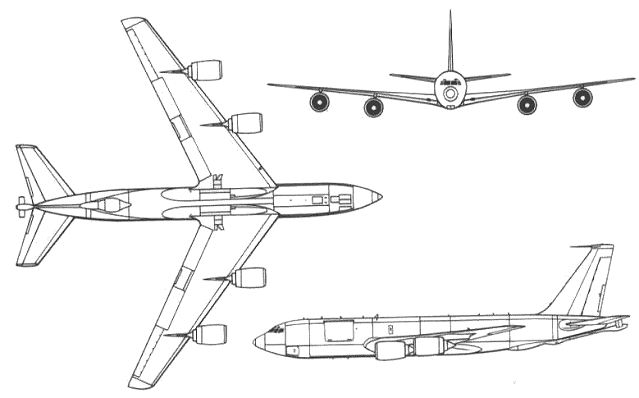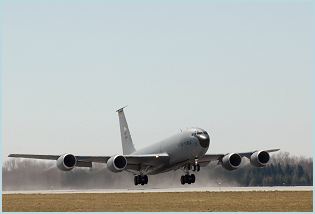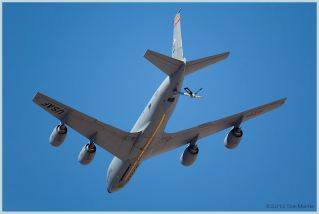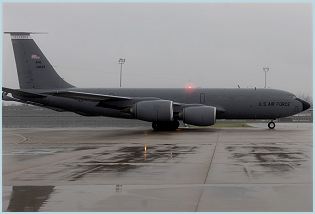KC-135 Stratotanker Boeing
| a | ||||||||||||||||||||||
|
KC-135 Boeing Stratotanker aerial refueling military aircraft
|
||||||||||||||||||||||
 |
||||||||||||||||||||||
|
|
||||||||||||||||||||||
|
The Boeing KC-135 Stratotanker is an aerial refueling military aircraft. It and the Boeing 707 airliner were developed from the Boeing 367-80 prototype. The KC-135 was the US Air Force's first jet-powered refueling tanker and replaced the KC-97 Stratotanker. The KC-135 Stratotanker provides the core aerial refueling capability for the United States Air Force and has excelled in this role for more than 50 years. This unique asset enhances the Air Force's capability to accomplish its primary mission of global reach. It also provides aerial refueling support to Air Force, Navy, Marine Corps and allied nation aircraft. The KC-135 is also capable of transporting litter and ambulatory patients using patient support pallets during aeromedical evacuations. |
||||||||||||||||||||||
|
Main Variants:
- KC-135R or KC-135T: Of the original KC-135As, more than 415 have been modified with new CFM-56 engines produced by CFM-International. The re-engined tanker, designated either the KC-135R or KC-135T, can offload 50 percent more fuel, is 25 percent more fuel efficient, costs 25 percent less to operate and is 96 percent quieter than the KC-135A. - NKC-135A: Through the years, the KC-135 has been altered to do other jobs ranging from flying command post missions to reconnaissance. RC-135s are used for special reconnaissance and Air Force Materiel Command's NKC-135As are flown in test programs. - OC-135: Air Combat Command operates the OC-135 as an observation platform in compliance with the Open Skies Treaty. |
||||||||||||||||||||||
| Technical Data | ||||||||||||||||||||||
| Design | ||||||||||||||||||||||
|
The KC-135R has four turbofan engines, mounted under 35-degree swept wings, which power it to takeoffs at gross weights up to 146,300 kg. The KC-135R Stratotankers are fitted with mk32B wingtip hose and drogue air refuelling pods. The additional system allows the KC-135R to refuel both probe / drogue and boom / receptacle aircraft on a single mission and to refuel two probe / drogue aircraft simultaneously. The KC-135 of U.S. Army was updated under the program GATM (Global Air Traffic Managemnt). The GATM upgrade program will focus primarily on upgrading the aircraft's communication and navigation systems to free operation in civil airspace.
|
||||||||||||||||||||||
| Avionics | ||||||||||||||||||||||
|
The latest generation of KC-135 Stratotanker are equipped with the Collins FMS-800 integrated flight management system, Collins FDS-255 liquid crystal flat-panel multifunction flight display, and the Collins WXR-700X forward-looking predictive windshear weather radar. The flight management system is integrated with a traffic alert and collision avoidance system (TCAS) and an enhanced ground proximity warning system (EGPWS). The communication system includes
GATM additions to the communications system include an Aero-I SAT-2000 satellite communications system and two FANs (future air navigation) capable CMU-900 Communication Management Units for data link applications. GATM additions to the navigation system include two Collins GNLU-955M multi-mode receivers, which contain individual modules for GPS, MLS and FM-Immune VOR/ILS (VHF omni-directional radio range steering guidance linked with an instrument landing system) capabilities. Additionally, one existing and one newly added embedded global positioning system / inertial navigation system (EGI) unit will possess 12-channel, all-in-view GPS receivers. |
||||||||||||||||||||||
| Propulsion | ||||||||||||||||||||||
|
Four turbofans CFM International CFM56, mounted under 35-degree swept wings, power the KC-135 to takeoffs at gross weights of up to 322,500 pounds. A cargo deck above the refueling system can hold a mixed load of passengers and cargo. Depending on fuel storage configuration, the KC-135 can carry up to 83,000 pounds of cargo.
|
||||||||||||||||||||||
| Capabilities | ||||||||||||||||||||||
|
Nearly all internal fuel can be pumped through the flying boom, the KC-135's primary fuel transfer method. One crewmember, known as the boom operator, is stationed in the rear of the plane and controls the boom during in-flight air refueling.
A special shuttlecock-shaped drogue attached to and trailing behind the flying boom may be used to refuel aircraft fitted with probes. Some aircraft have been configured with the multipoint refueling system, which consists of special pods mounted on the wingtips. These KC-135s are capable of refueling two receiver aircraft at the same time. |
||||||||||||||||||||||
| Specifications | ||||||||||||||||||||||
|
||||||||||||||||||||||
 |
||||||||||||||||||||||
|
||||||||||||||||||||||































